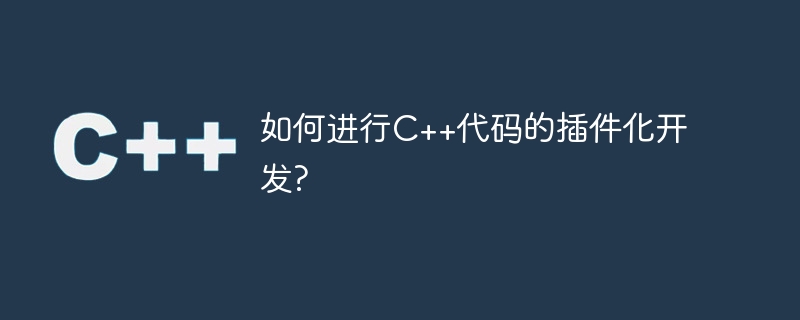Home >Backend Development >C++ >How to perform plug-in development of C++ code?
How to perform plug-in development of C++ code?
- WBOYWBOYWBOYWBOYWBOYWBOYWBOYWBOYWBOYWBOYWBOYWBOYWBOriginal
- 2023-11-04 11:25:431667browse

How to carry out plug-in development of C code?
In C programming, plug-in development is a common technical means, which can divide the functions of the program into different modules to make the program scalable and flexible. This article will introduce how to perform plug-in development of C code to help readers better understand and apply this technology.
1. In-depth understanding of the concept of plug-in development
The core idea of plug-in development is to divide the functions of the program into different modules, and each module is called a plug-in. A plug-in is a dynamic link library (DLL) or shared library (SO) that contains a series of extensible functional interfaces and implementation codes. By loading and unloading plug-ins, programs can dynamically add or remove functionality as needed.
The advantages of plug-in development include: 1) Reduce the coupling of the code and improve the maintainability and reusability of the code; 2) Using the independence of the plug-in, the program can be hot updated and dynamically adjusted ;3) Convenient for multi-person collaborative development, different developers can develop different plug-ins at the same time to improve development efficiency.
2. Determine the plug-in interface and specifications
Before plug-in development, you first need to determine the plug-in interface and specifications. The plug-in interface refers to the functional interface exposed by the plug-in to the main program. It defines the communication method and data format between the plug-in and the main program.
Plug-in specification refers to the naming specification, directory structure specification and development guide of the plug-in. The naming convention of the plug-in can agree on the name, version number and other information of the plug-in; the directory structure specification can define the file organization method of the plug-in; the development guide can include precautions for plug-in development and sample code, etc.
3. Loading and managing plug-ins
The main program needs to provide the function of loading and managing plug-ins. Through a dynamic link library (such as dlopen/dlsym) or a shared library (such as LoadLibrary/GetProcAddress), the main program can dynamically load the plug-in at runtime and obtain the functional interface defined in the plug-in.
The main program can use a plug-in manager to manage plug-ins, which is responsible for loading, unloading and calling plug-ins. The plug-in manager can implement plug-in version management, dependency management, conflict resolution and other functions to ensure mutual compatibility and stability between plug-ins.
4. Plug-in development
When developing plug-ins, it needs to be developed in accordance with plug-in interfaces and specifications. The development of plug-ins can be carried out independently from the main program, and developers can use the C programming language and corresponding development tools (such as IDE) for development.
The plug-in development process can include the following steps: 1) Define the plug-in interface, including the plug-in’s function prototype and data structure; 2) Implement the functions of the plug-in, including externally exposed interfaces and internally implemented functions; 3) Compile the plug-in source code and generate the plug-in's dynamic link library or shared library; 4) Test the function and performance of the plug-in to ensure the quality and stability of the plug-in.
5. Application examples of plug-in development
Plug-in development has many application examples in actual projects. For example, a graphics processing software can use different image filters and special effects as plug-ins. Users can select and load different plug-ins as needed to process and beautify images. For another example, a network server program can use different protocol processing modules as plug-ins, and dynamically load and unload plug-ins according to different needs of network traffic to achieve flexible processing of different protocols.
Plug-in development can also be combined with technologies in other fields, such as hot update of plug-ins, remote calling of plug-ins, etc., to achieve more functions and scalability.
Summary:
Plug-in development is a common technical means that can improve the maintainability and scalability of the program. In C programming, plug-in development can be achieved by loading and managing plug-ins. The main program needs to determine the plug-in interface and specifications, and develop and test plug-ins. Plug-in development has a wide range of applications in actual projects and can be combined with other technical means to achieve more functions and flexibility. I hope this article can help readers better understand and apply plug-in development technology for C code.
The above is the detailed content of How to perform plug-in development of C++ code?. For more information, please follow other related articles on the PHP Chinese website!

